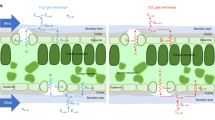Abstract
The chemistry of leaf cuticles (e. g., Holloway, 1994) and the permeation of cuticles by nonelectrolytes (e. g., Kerstiens, 1994; Riederer et al, 1994) are much better understood than is the permeation of ionic species, e. g., salts and acids. Ions differ from nonelectrolytes in that they carry a net electric charge. Ions and nonelectrolytes both diffuse in response to concentration gradients in solution, but ions are unique in being moved by electric gradients in addition to concentration gradients. If the force associated with an electric gradient is larger in magnitude and opposite in direction to the concentration gradient, then ionic species can move from regions of low to high concentration. In general, when salts and acids diffuse, an electric gradient, called a diffusion potential is generated; this electric gradient will retard the rate of diffusion of some ions and speed up the rate of others. Failure to recognize the influence of electric gradients can lead to errors or vagueness in interpretation of results (see below).
Access this chapter
Tax calculation will be finalised at checkout
Purchases are for personal use only
Preview
Unable to display preview. Download preview PDF.
Similar content being viewed by others
References
Becker M, Kerstiens G, Schönherr J (1986) Water permeability of plant cuticles: permeance, diffusion and partition coefficients Trees 1: 54–60
Crank J, Park GS (1968) Diffusion in Polymers Academic Press. London New York.
Holloway PJ (1994) The plant cuticle: Biosynthesis and physicochemical characteristics. ( This volume, pp 1–13 )
Hauser HD, Walters KD, Berg VS (1993) Patterns of effective permeability of leaf cuticles to acids. Plant Physiol 101: 251–257
Kerstiens G (1994) Air pollutants and plant cuticles: mechanisms of gas and water transport and effects on water permeability. (This volume, pp 79–92)
McFarlane JC, Berry WL (1974) Cation penetration through isolated leaf cuticles. Plant Physiol 53: 723–727
Nobel PS (1991) Physicochemical and Environmental Plant Physiology Academic Press. London Sydney Tokyo Toronto
Riederer M, letter R, Markstadter C, Schreiber L (1994) Air pollutants and the cuticle: Implications for plant physiology. (This volume, pp)
Robinson RA, Stokes RH (1970) Electrolyte Solutions Butterworths London
Schönherr J (1976) Water permeability of isolated cuticular membranes: the effect of cuticular waxes on diffusion of water. Planta 131:159–164.
Smalley SJ, Hauser HD, Berg VS (1993) Effects of cations on effective permeability of leaf cuticles to sulfuric acid. Plant Physiol 103: 251–256
Tyree MT (1968) Determination of transport constants of isolated Nitella cell walls. Can J Bot 46: 317–327
Tyree MT, Tabor CA, Wescott CR (1990) Movement of cations through cuticles of Citrus aurantium and Acer saccharum: Diffusion potentials in mixed salt solutions. Plant Physiol 94: 120–126
Tyree MT, Scherbatskoy TD, Tabor CA (1990) Leaf cuticles behave as asymmetric membranes: Evidence from the measurement of diffusion potentials. Plant Physiol 92: 103–109
Tyree MT, Wescott CR, Tabor CA (1991) Diffusion and electric mobility of ions within isolated cuticles of Citrus aurantium. Plant Physiol 97: 273–279
Tyree MT, Wescott CR, Tabor CA, Morse AD (1992) Diffusion and electric mobility of KC1 within isolated cuticles of Citrus aurantium. Plant Physiol 99: 1057–1061
Author information
Authors and Affiliations
Editor information
Editors and Affiliations
Rights and permissions
Copyright information
© 1994 Springer-Verlag Berlin Heidelberg
About this paper
Cite this paper
Tyree, M.T. (1994). Ion Transport Across Leaf Cuticles: Concepts and Mechanisms. In: Percy, K.E., Cape, J.N., Jagels, R., Simpson, C.J. (eds) Air Pollutants and the Leaf Cuticle. NATO ASI Series, vol 36. Springer, Berlin, Heidelberg. https://doi.org/10.1007/978-3-642-79081-2_4
Download citation
DOI: https://doi.org/10.1007/978-3-642-79081-2_4
Publisher Name: Springer, Berlin, Heidelberg
Print ISBN: 978-3-642-79083-6
Online ISBN: 978-3-642-79081-2
eBook Packages: Springer Book Archive




